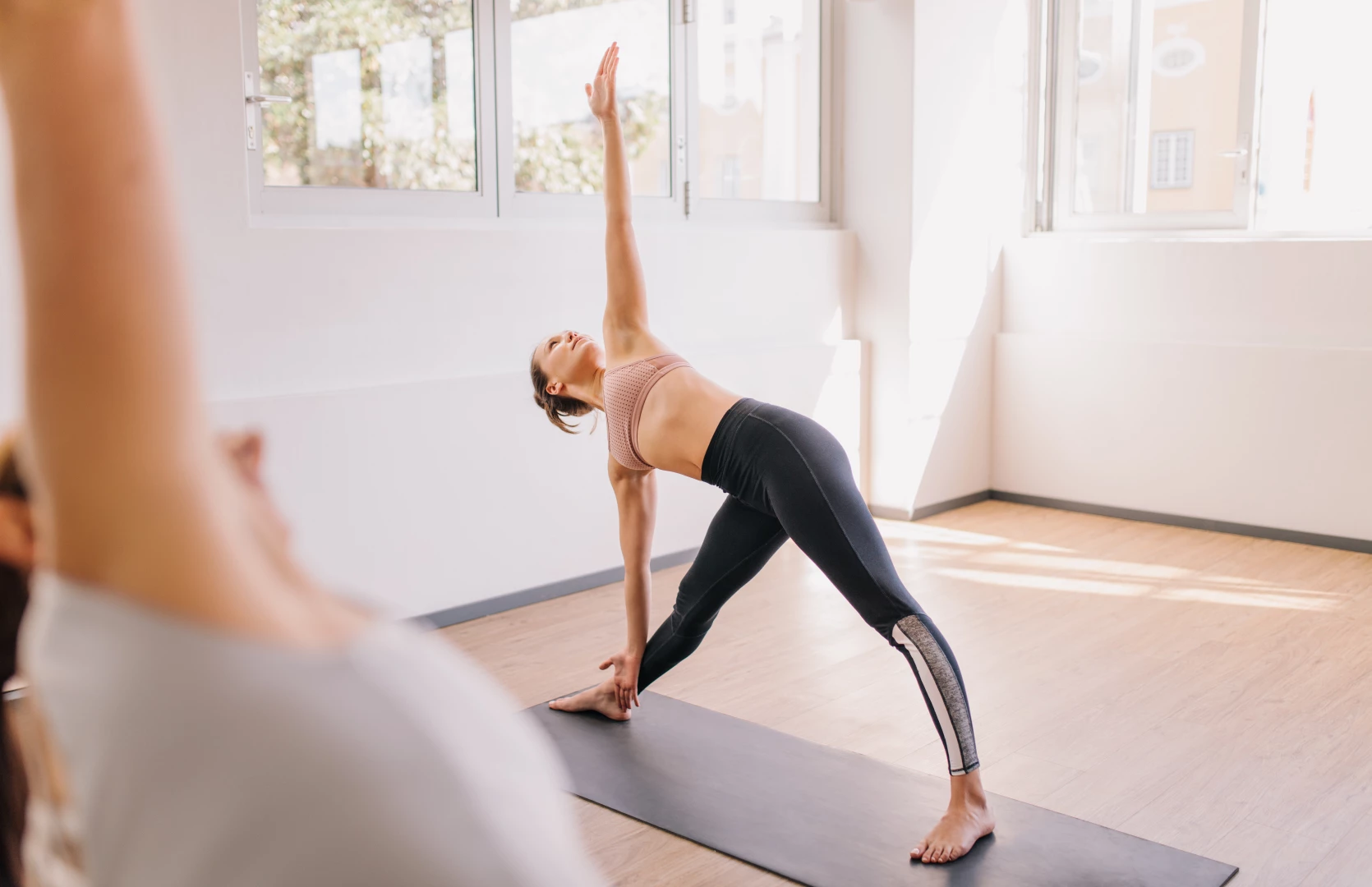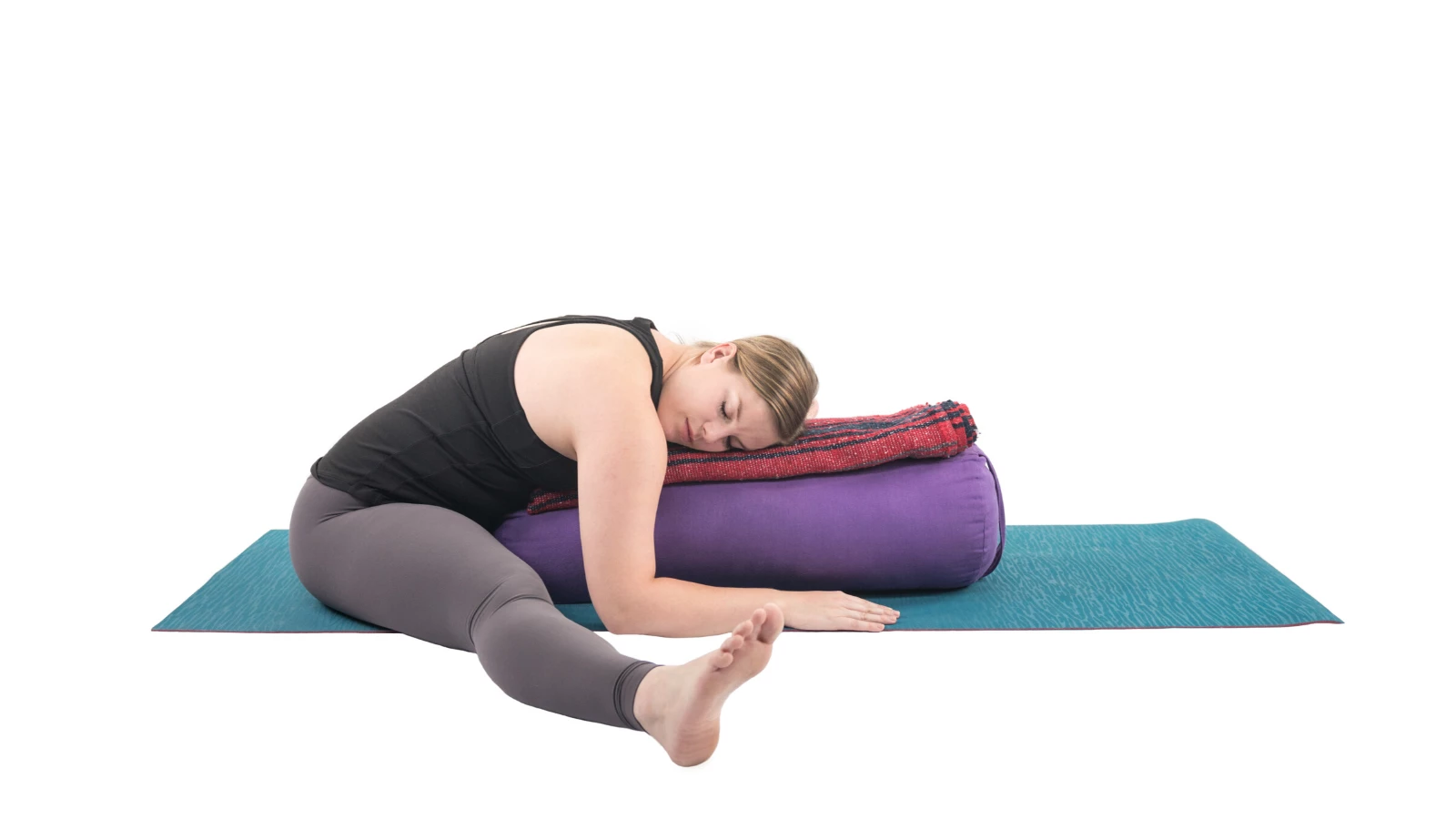7 Key Actions to Bring Greater Awareness to the Lower Body in Yoga Poses Like Triangle and Warrior II

Problem: For many beginning yoga students, it can be challenging to come into the wide-legged stance needed for many standing yoga postures, like Trikonasana (Triangle Pose) and Virabhadrasana II (Warrior II)
Solution: Try to these 7 key yoga actions for lower body awareness to get more familiar with the actions in a wide-legged stance.
For most beginning yoga students, wide-legged standing poses, such as Triangle Pose and Warrior II, can be challenging. There are different reasons for this, but typically, the difficulties start with the wide-legged stance itself.
Think about this: How often do you stand with your feet wider than your hips throughout the course of your day? Pretty much never, right?
As a result, most people come to class with tight inner thighs. So, when it comes to practicing wide-legged standing poses such as Trikonasana (Triangle Pose) and Virabhadrasana II (Warrior II), the first challenge for students is to come into a sufficiently wide stance.
My students often assume a narrow stance, rather than an exaggerated one, and I can’t help but think it has something to do with our mentality about how much space we are “allowed” to fill up with our bodies. Here are seven key yoga actions for lower body awareness.

Set Your Foundation: 7 Tips to Widen Your Stance in Wide-Legged Standing Yoga Poses
-
Treat the Wide-Legged Stance as Its Own Pose

Usually, the wide-legged stance is treated as a quick pass-through on the way to the actual pose. E.g. “Take a wide stance, then point the front foot to the front and the back foot at a 45 degree angle. Then. . . . . “ You get the point.
However, When we learn new and unaccustomed ways to move our bodies, we need to take time to develop each step, otherwise it’s hard to immediately get the volume of the movement correct. If we rush through unfamiliar movements, we often either exaggerate or reduce the size of the movement at first because it feels foreign. We haven’t yet calibrated our senses to what is correct for our body’s proportions.
So, treat the wide-legged stance as its own yoga pose and use the points below to refine and get to know it. (It actually is – see Utthita Tadasana, Five-Pointed Star!) You’ll find that there’s a lot to explore. -
Take Time to Arrive in the Pose
Standing with the feet wide apart is an inhabitual movement for most beginning yoga students. So tip number one is to simply ‘Take Your Time to Arrive in the Pose!’
It takes time for the body to get used to the new movement and for the muscles to adjust to the stretch.
So simply come into the pose, wait for a short while (e.g.20-30 seconds), then heel-toe the feet a bit wider and so on. Rinse and repeat, until it feels like the body is not adjusting anymore. That’s the limit of your stretch for today. You’ll be surprised how much your body will adjust in just a minute or two.
Use this time of adjustment to draw attention to other parts of the body in the pose, using some of the additional actions below. -
Activate Your Feet, and Your Legs Will Follow
Play with engaging the feet in different ways in the pose. Press down into your feet as if you’re trying to split your mat apart – feel which muscles engage. Draw the feet toward each other, again exploring which muscles engage and how it feels. Press the deep toe mound into the floor and allow that action to create a sense of lift through the entire body.
Optionally, put a block at the wall, so you have resistance for one foot to press against. After each variation, take a moment to heel-toe your feet a few fractional inches further apart. As you press into your feet, notice how your calves and outer thigh muscles activate. This activation helps to create a solid foundation for all poses with a wide stance. -
Pay Attention to Your Pelvis.
For many people, practicing step number three naturally causes the pelvis to spill forward, which creates a subtle backbend in the lower back. Counter this tendency by lifting the front of your hips up away from the ground and draw your belly button in and up toward your spine.
-
Stack Your Spine for Success.
Lengthen your spine and imagine lifting your ribcage away from your hips to assume your full height.
-
Finding a Deep Rotation in the Hip
Triangle Pose, Warrior II, and Extended Side Angle are not only wide-legged standing yoga poses, but they also have one leg that is externally rotated—yet another complicated action that takes time and attention to learn.
To rotate your front thigh, allow your front knee to bend, and lift the heel of your front foot a few inches off the ground. Rotate your leg so your knee and toes face toward the top of your mat.
Think about this rotation happening deep inside your hip socket. This is not a superficial movement, or simply the knee moving forward. The head of the femur (the very top of your thigh bone) is rotating outward from within your hip socket. -
Leave the Panes Behind

As you add the movements of Trikonasana or Virabhadrasana II, make sure to allow your back hip to slightly rotate inward. Don’t force your hips to be square and face the long edge of your mat.
When you rotate your back hip inward, your back leg will also come into a bit of internal rotation. This means you would move your back heel toward the short edge of the back of your mat.
Embrace Wide-Legged Standing Poses.
While Trikonasana and Virabhadrasana II may be complicated, they also offer many benefits. Now that you know which key actions to incorporate, you may find that you can approach these yoga poses and and other wide-legged standing postures with newfound confidence.
Did you find these key yoga actions for lower body awareness? If so, check out this full five-minute practice for even more tips to practice wide-legged yoga poses.



